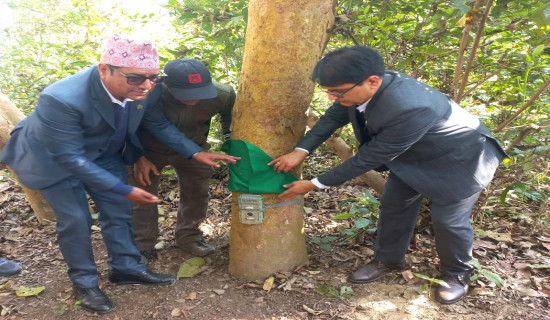- Tuesday, 16 December 2025
Learning From Chengdu’s Green Development
China’s march towards modernisation is truly momentous. Its experiences and insights hold prospects for other countries striving for rapid economic development and prosperity. Recently, a group of Nepali journalists had the opportunity to visit Chengdu, which reflects China's unique path of development as well as its measures for preserving culture, endangered animals, natural habitat, and biodiversity. Located on the western flank of China, Chengdu showcases the country's financial, cultural, informational technology, aviation, pharmaceutical, and defence power.
Also, the capital city of Sichuan Province, Chengdu, is famous for its stunning natural beauty, delicious cuisine, thriving cosmopolitan civilizations, and vibrant tourism. As one visits the Giant Panda Breeding Centre, the Dujiangyan Irrigation System, Zhanqi Village, and the Sanxingdui Museum, China’s translation of indigenous concepts for the development and preservation of antiquity comes to the fore. These have left an indelible impression on this scribe, and this article seeks to ponder various facets of mesmerising development while drawing valuable insight for Nepal.
Industrial transformation
Chengdu has become an industrial hub with domestic and foreign investment, promoting technological innovation, manufacturing, and the service sector. The provincial government has adopted policies and strategies conducive to local business and the growth of foreign companies. One of the striking features of Chengdu is its well-planned urban infrastructure. From efficient transportation networks to modernised urban centres, Chengdu exemplifies integrated transportation systems, green spaces, and sustainable architecture to support its growing population and enhance quality of life. China’s 14th Five-Year Plan has laid emphasis on innovation-driven growth, low-carbon development, and the integration of urban and rural areas. “We have attached importance to high-quality green development and emphasised innovation as the core of modern development," said Prof. Qiu Yonghui, Deputy Director, China Centre for South Asian Studies, Sichuan University.
Chengdu prioritises environmental sustainability as a vital component of its development strategy. The city has implemented measures to reduce pollution levels, enhance waste management, and promote renewable energy sources. Its specific initiatives, such as the introduction of green technologies, urban greening projects, and sustainable waste management models, could serve as a template for the sustainable management of garbage that frequently pesters the Kathmandu Valley.
Chengdu's development journey also reflects its commitment to preserving cultural heritage and utilising it for tourism development. The city boasts numerous cultural attractions, such as the Qingcheng Daoist Mountain and the Sanxingdui Museum. Cultural tourism has stimulated economic growth while safeguarding its rich cultural heritage. Chengdu Research Base for Giant Panda Breeding has well-equipped research facilities and has become a global tourist centre. It demonstrates China's commitment to wildlife conservation and sustainable tourism. Nepal, which is rich in wildlife and biodiversity, can learn from the Chengdu Panda Base to preserve similar endangered animals and promote tourism. China has made Panda a global brand. Nepal can also develop a similar modern research centre to protect and popularise one-horned rhinos that are vulnerable on the IUCN Red List.
The Dujiangyan Irrigation System and Mount Qingcheng, located in the western portion of the Chengdu flatlands, show China's expertise in harnessing nature for prosperity. The ancient irrigation system displayed sustainable water management and its positive impact on rural communities. The ecological harmony of Qingcheng Mountain stands as a model for preserving natural resources while promoting tourism. The Dujiangytan irrigation system is considered an engineering marvel that has provided water resources to the region for over two millennia. As a fitting example of ecological civilization, it has been helpful to check flood control and the decline of sediment without the construction of big dams. Known as the birthplace of Taoism, Mount Qingcheng hosts historic Taoist temples with the traditional architecture of western Sichuan. Nepal, endowed with thousands of rivers, green hills, and snow-capped mountains, can draw indigenous techniques from Chengdu to conserve ecology and tap abundant water resources.
Empowering rural communities
A visit to Zhanqi Village, which is situated in Pidu District in Chengdu City, offers a glimpse of the empowerment of rural communities. By focusing on comprehensive planning, infrastructure development, and skill training, the village has undergone transformation. The people have achieved self-sufficiency in their basic needs. It has witnessed the boom of ‘live culture’ and local industries. As Nepal has long adopted the notion of village tourism, the Zhanqi model can be followed to bridge the urban-rural divide and promote socio-economic development. By investing in rural infrastructure, improving access to education and healthcare, and conducting vocational training, Nepal can revitalise villages to make them self-reliant and raise the living standards of the people.
Visiting Tianfu New Area exhibits China’s technologically advanced and people-centric urban development. The integration of innovation, infrastructure, and sustainability underscored its ambition to build livable cities for its citizens. “Tianfu New Area resembles the futuristic vision of sustainable urban planning and technological invention,” says Xiao Jianemi, an Associate Professor at Sichuan University. This forward-looking urban development area demonstrated the potential for smart cities in Nepal. By integrating eco-friendly architecture, efficient transportation systems, and advanced digital infrastructure, Nepal can create sustainable urban hubs that attract investments, improve quality of life, and drive economic growth.
China has made miraculous progress in poverty alleviation, mega-infrastructure development, international trade, tourism, information technology, clean energy, aviation, and artificial intelligence, among others. It possesses capital, managerial skills, and experience in building mega projects, which are highly beneficial for Nepal reeling from widespread poverty, unemployment, a dearth of investment, a trade deficit, and imbalanced development. Nepal and China have enjoyed cordial relations since time immemorial. The nations have engaged in practical cooperation in diverse fields of mutual interest. So, Nepal should pursue proactive diplomacy to benefit from the second-largest economy.
(Neupane is a programme producer at Nepal Television.)
















